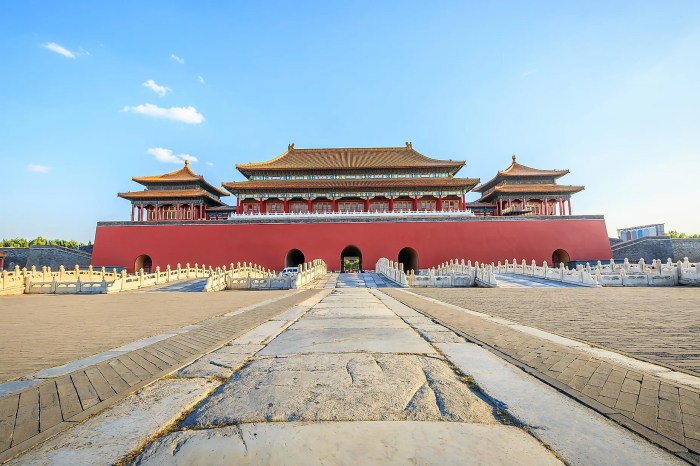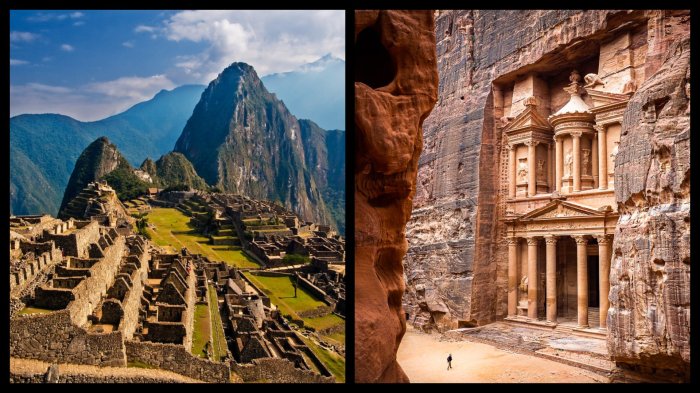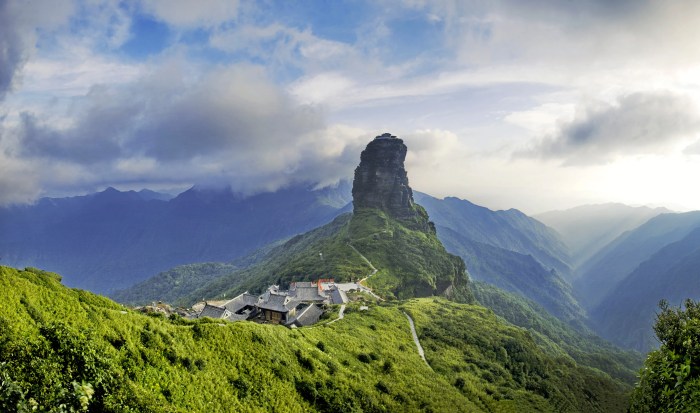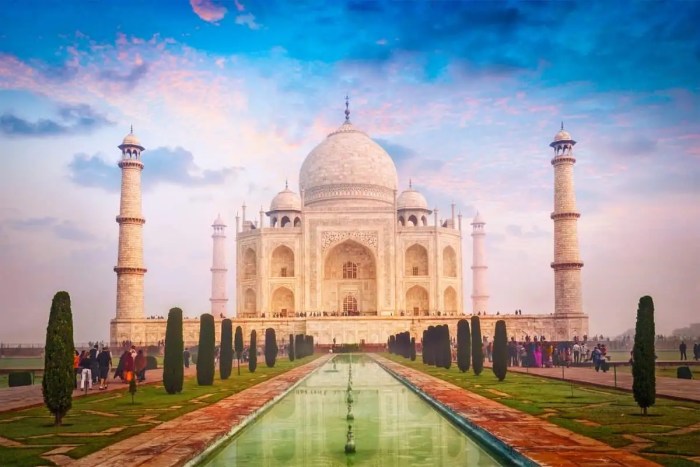UNESCO World Heritage Sites are beacons of cultural and natural significance, recognized for their outstanding universal value. Designated by the United Nations Educational, Scientific and Cultural Organization (UNESCO), these sites embody the rich tapestry of human history, natural wonders, and the intricate relationship between humanity and the environment.
From the iconic Great Wall of China to the breathtaking natural beauty of the Grand Canyon, UNESCO World Heritage Sites span the globe, representing the diversity and interconnectedness of our shared heritage. Join us on a journey to discover the significance, types, and challenges of preserving these invaluable treasures for generations to come.
UNESCO World Heritage Sites

UNESCO World Heritage Sites are places of outstanding universal value to humanity and are designated as such by the United Nations Educational, Scientific and Cultural Organization (UNESCO). These sites can be natural, cultural, or a combination of both. They are protected by international treaties and are considered to be part of the world’s cultural and natural heritage.
The designation criteria for UNESCO World Heritage Sites are based on the following six criteria:
- Outstanding universal value
- Integrity and authenticity
- Protection and management
- Public access
- Education and interpretation
- Sustainable development
As of 2023, there are 1,154 UNESCO World Heritage Sites in 167 countries. These sites are divided into three categories:
- Cultural sites (897)
- Natural sites (218)
- Mixed sites (39)
Some of the most famous UNESCO World Heritage Sites include the Great Wall of China, the Taj Mahal, the Pyramids of Giza, and the Grand Canyon. These sites are all unique and special in their own way, and they represent the diversity of the world’s cultural and natural heritage.
Cultural World Heritage Sites

Cultural World Heritage Sites are designated by UNESCO as having outstanding universal value and cultural significance. They represent the diversity of human history, creativity, and achievement.
UNESCO World Heritage Sites offer a glimpse into our planet’s rich cultural and natural heritage. Many of these sites are also committed to sustainable practices, making them ideal destinations for travelers seeking eco-friendly adventures. From the lush rainforests of the Amazon to the ancient ruins of Petra, sustainable travel destinations offer a unique blend of history, culture, and environmental awareness.
Whether you’re a seasoned traveler or a first-time explorer, UNESCO World Heritage Sites provide an unforgettable opportunity to connect with the world’s cultural and natural wonders while supporting sustainable tourism.
These sites can include ancient ruins, historical monuments, religious structures, and cultural landscapes. They provide a glimpse into the past and help us to understand the different cultures that have shaped our world.
Iconic Cultural World Heritage Sites
Some of the most iconic Cultural World Heritage Sites include:
- The Great Wall of China
- The Taj Mahal
- The Pyramids of Giza
- The Colosseum
- The Statue of Liberty
Importance of Preserving Cultural Heritage
Preserving and protecting cultural heritage is important for future generations. These sites are not only a source of pride and inspiration, but they also provide valuable insights into our past and help us to understand the different cultures that have shaped our world.
By protecting cultural heritage, we are ensuring that future generations will be able to learn from and enjoy these treasures.
Natural World Heritage Sites
Natural World Heritage Sites are designated by UNESCO based on their exceptional geological or ecological significance. These sites represent the Earth’s natural wonders, showcasing diverse ecosystems, unique landscapes, and remarkable geological formations.
When visiting UNESCO World Heritage Sites, it’s important to be mindful of your impact on the environment. Eco-friendly travel tips can help you reduce your carbon footprint while still enjoying these incredible places. From using public transportation to choosing sustainable accommodations, there are many ways to travel responsibly.
By following these tips, you can help protect these sites for future generations to enjoy.
To be designated as a Natural World Heritage Site, a site must meet at least one of the following criteria:
- Exceptional natural beauty or aesthetic importance.
- Outstanding examples of major stages of Earth’s history, including the record of life, geological processes, and significant geomorphic features.
- Superlative natural phenomena or areas of exceptional natural beauty.
- Important and significant natural habitats for in-situ conservation of biological diversity, including those containing threatened species of outstanding universal value from the point of view of science or conservation.
Notable Natural World Heritage Sites
Some notable Natural World Heritage Sites include:
- Yellowstone National Park, USA
- Great Barrier Reef, Australia
- Amazon Rainforest, Brazil
- Serengeti National Park, Tanzania
- Grand Canyon National Park, USA
- Iguazu Falls, Argentina and Brazil
- Mount Everest National Park, Nepal
UNESCO’s Role in Natural World Heritage Sites
UNESCO plays a vital role in promoting sustainable tourism and conservation efforts at Natural World Heritage Sites. The organization provides financial and technical assistance to countries to protect and manage these sites, and it works with local communities to develop sustainable tourism practices that support conservation goals.
Mixed World Heritage Sites

Mixed World Heritage Sites are designated by UNESCO as areas that possess both cultural and natural significance, combining the criteria for both cultural and natural heritage sites.
These sites showcase the intricate relationship between human history, culture, and the natural environment, often representing a unique blend of cultural practices, traditions, and the preservation of biodiversity.
Examples of Mixed World Heritage Sites, UNESCO World Heritage Sites
- Machu Picchu Historic Sanctuary, Peru: An ancient Inca city perched high in the Andes Mountains, Machu Picchu exhibits both cultural significance as a testament to Inca civilization and natural beauty, surrounded by stunning mountain peaks and cloud forests.
- Serengeti National Park, Tanzania: Known for its vast savanna ecosystem and abundant wildlife, the Serengeti also holds cultural significance for the Maasai people, who have traditionally grazed their livestock in the area for centuries.
- Uluru-Kata Tjuta National Park, Australia: The iconic Uluru (Ayers Rock) and Kata Tjuta (The Olgas) are sandstone formations that hold immense cultural significance for the Aboriginal people, while also showcasing the unique geology and desert landscapes of the region.
Challenges and Opportunities in Managing Mixed World Heritage Sites
Managing mixed World Heritage Sites presents unique challenges, as it requires balancing the preservation of both cultural and natural heritage. This involves:
- Coordinating between different stakeholders, including cultural heritage experts, conservationists, and local communities, to ensure a comprehensive approach to management.
- Addressing potential conflicts between cultural practices and conservation goals, such as the impact of tourism on sensitive natural areas.
- Developing integrated management plans that consider both the cultural and natural values of the site and ensure their long-term sustainability.
Despite these challenges, mixed World Heritage Sites offer exceptional opportunities for:
- Promoting sustainable tourism that respects both cultural and natural heritage, generating economic benefits for local communities.
- Raising awareness about the importance of preserving cultural landscapes and the harmonious coexistence of humans and nature.
- Fostering cultural exchange and dialogue between different communities and cultures, promoting understanding and appreciation for diverse heritage.
Preservation and Conservation
Preserving and conserving UNESCO World Heritage Sites is crucial for ensuring their longevity and accessibility for future generations. These sites hold immense historical, cultural, and natural significance, and it is our responsibility to safeguard them for posterity.
UNESCO World Heritage Sites face various challenges and threats, including climate change, pollution, and human activities. Climate change poses a significant threat to natural sites, leading to rising sea levels, altered weather patterns, and increased frequency of extreme weather events. Pollution from industries, vehicles, and agriculture can damage cultural sites, causing erosion and discoloration of monuments. Human activities, such as uncontrolled tourism, illegal logging, and mining, can also harm these sites.
Successful Conservation Efforts
Despite these challenges, numerous successful conservation efforts have been implemented at World Heritage Sites. These initiatives demonstrate the importance of collaboration, innovation, and community involvement in preserving our heritage.
- Restoration of the Great Wall of China: Extensive restoration projects have been undertaken to repair and strengthen sections of the Great Wall, protecting it from erosion and collapse.
- Conservation of the Angkor Wat Complex: A comprehensive conservation program has been implemented to preserve the ancient temples of Angkor Wat, including restoration of structures, sustainable tourism management, and community engagement.
- Reforestation of the Galapagos Islands: Restoration efforts have been successful in reintroducing native plant species to the Galapagos Islands, combating invasive species and protecting the unique ecosystem.
These conservation efforts serve as testaments to the resilience and dedication of individuals and organizations committed to preserving our World Heritage Sites for generations to come.
Tourism and World Heritage Sites

Tourism at UNESCO World Heritage Sites offers a multitude of potential benefits. It can boost local economies, create employment opportunities, and foster cultural exchange. However, it also poses challenges, such as the potential for damage to fragile sites, overcrowding, and the commodification of cultural heritage.
Importance of Sustainable Tourism Practices and Visitor Management Strategies
To address these challenges, it is essential to implement sustainable tourism practices and effective visitor management strategies. These include limiting visitor numbers, establishing designated trails and viewing areas, and educating tourists about responsible behavior.
Recommendations for Responsible Tourism at World Heritage Sites
- Respect the site: Follow designated trails, avoid touching or damaging structures, and dispose of waste properly.
- Be mindful of local customs and traditions: Dress appropriately, respect local beliefs and practices, and avoid causing noise or disturbance.
- Support local businesses: Patronize local restaurants, shops, and tour operators to contribute to the local economy.
- Learn about the site: Take guided tours, read informational materials, and engage with local experts to enhance your understanding and appreciation.
- Spread the word: Share your positive experiences and encourage others to visit the site responsibly.
Educational Value

UNESCO World Heritage Sites hold immense educational value, fostering cultural exchange and understanding. They serve as platforms for learning about diverse cultures, histories, and natural wonders, promoting appreciation and respect for the world’s heritage.
When exploring UNESCO World Heritage Sites, consider adopting eco-friendly travel tips to minimize your environmental impact. Simple actions like reducing waste, choosing sustainable transportation, and supporting local businesses can preserve these treasured landmarks for future generations while enhancing your travel experience at these UNESCO World Heritage Sites.
Cultural Exchange and Learning
World Heritage Sites facilitate cultural exchange by bringing together individuals from different backgrounds to experience and engage with various cultural traditions. Through guided tours, educational programs, and immersive experiences, visitors gain insights into different ways of life, fostering empathy and breaking down cultural barriers.
Cultural Understanding and Appreciation
These sites also promote cultural understanding by showcasing the tangible and intangible aspects of human heritage. By preserving and protecting cultural artifacts, traditions, and landscapes, World Heritage Sites allow visitors to appreciate the diversity of human expression and the interconnectedness of different cultures.
Educational Programs and Initiatives
Many World Heritage Sites offer educational programs and initiatives to enhance their educational impact. These programs range from interactive workshops and lectures to school visits and online resources. They aim to engage learners of all ages, fostering a lifelong appreciation for cultural and natural heritage.
Regional Distribution

UNESCO World Heritage Sites are distributed unevenly across the globe, with some regions having a significantly higher concentration than others. This distribution is influenced by various factors, including historical, cultural, and geographical factors.
Factors Influencing Distribution
- Historical Significance: Regions with a rich and diverse history, such as Europe and Asia, tend to have a higher number of World Heritage Sites due to the presence of ancient monuments, historical cities, and cultural landscapes.
- Cultural Diversity: Regions with a diverse range of cultures, such as Africa and Latin America, have a greater representation of World Heritage Sites that showcase the unique cultural traditions, beliefs, and practices of different communities.
- Geographical Features: Natural World Heritage Sites are often found in regions with unique and exceptional geological formations, ecosystems, and biodiversity, such as the rainforests of the Amazon and the coral reefs of the Great Barrier Reef.
- Political and Economic Factors: The political and economic stability of a region can influence the preservation and conservation of cultural and natural heritage sites. Stable and prosperous regions are more likely to have the resources and infrastructure to protect and manage their heritage sites.
Representation of Cultures and Ecosystems
The regional distribution of World Heritage Sites reflects the diversity of cultures and ecosystems around the world. For example, Europe has a high concentration of cultural World Heritage Sites, including historical monuments, architectural masterpieces, and urban landscapes that showcase the region’s rich history and cultural heritage.
In contrast, Africa and Latin America have a greater representation of natural World Heritage Sites, including rainforests, savannas, and mountain ranges that are home to a wide variety of plant and animal species. These regions also have a significant number of cultural World Heritage Sites that reflect the diverse traditions and cultures of indigenous communities.
Intangible Cultural Heritage

Intangible cultural heritage encompasses the practices, expressions, knowledge, and skills that communities, groups, and individuals recognize as part of their cultural heritage. It includes oral traditions, performing arts, social practices, rituals, festive events, traditional craftsmanship, and knowledge and practices concerning nature and the universe.
UNESCO’s recognition of intangible cultural heritage aims to safeguard and promote these valuable traditions and expressions that contribute to cultural diversity and human creativity.
Examples of Intangible Cultural Heritage
- Traditional crafts, such as weaving, pottery, and metalworking
- Performing arts, including music, dance, and theater
- Oral traditions, such as storytelling, poetry, and proverbs
- Social practices, such as rituals, ceremonies, and festivals
- Traditional knowledge and practices concerning nature and the universe, such as herbal medicine and astronomy
Challenges and Opportunities in Safeguarding and Promoting Intangible Cultural Heritage
Safeguarding intangible cultural heritage poses challenges due to its intangible nature, making it susceptible to loss and erosion. Additionally, globalization and modernization can threaten traditional practices and expressions.
However, UNESCO’s efforts provide opportunities for safeguarding and promoting intangible cultural heritage. Through the Convention for the Safeguarding of the Intangible Cultural Heritage, UNESCO promotes awareness, documentation, and revitalization efforts.
Recognizing intangible cultural heritage as a valuable asset can contribute to cultural diversity, creativity, and sustainable development. By fostering respect for cultural traditions, UNESCO’s initiatives contribute to building inclusive and peaceful societies.
World Heritage in Danger: UNESCO World Heritage Sites

UNESCO designates World Heritage Sites “in danger” when they face significant threats to their preservation. These threats can include natural disasters, armed conflict, pollution, or unsustainable development. As of 2023, there are 53 World Heritage Sites on the List of World Heritage in Danger.
Reasons for Inclusion on the List
The reasons for including a World Heritage Site on the List of World Heritage in Danger vary depending on the specific site. However, some of the most common threats include:
- Natural disasters: Earthquakes, floods, and other natural disasters can cause significant damage to World Heritage Sites, destroying buildings, artifacts, and natural features.
- Armed conflict: War and civil unrest can lead to the destruction of World Heritage Sites, as well as the displacement of local communities.
- Pollution: Air and water pollution can damage World Heritage Sites, causing erosion, discoloration, and other forms of deterioration.
- Unsustainable development: The construction of new buildings, roads, and other infrastructure can damage World Heritage Sites, as well as disrupt the surrounding environment.
Role of UNESCO and Other Organizations
UNESCO works with other organizations, including the International Council on Monuments and Sites (ICOMOS) and the International Union for Conservation of Nature (IUCN), to protect and restore World Heritage Sites in danger. UNESCO provides financial assistance, technical expertise, and training to help countries preserve their World Heritage Sites. The organization also works to raise awareness of the importance of World Heritage Sites and to promote sustainable tourism.
Other organizations, such as the World Monuments Fund and the Global Heritage Fund, also play a role in protecting World Heritage Sites in danger. These organizations provide funding, technical assistance, and advocacy to help preserve and restore World Heritage Sites.
Final Wrap-Up
As we delve into the world of UNESCO World Heritage Sites, we uncover the profound impact they have on our understanding of human history, cultural diversity, and the fragility of our natural environment. These sites serve as reminders of the importance of preserving our shared heritage, fostering cultural exchange, and promoting sustainable practices. By safeguarding these treasures, we not only protect the past but also invest in the future, ensuring that these extraordinary places continue to inspire and enrich generations to come.
FAQ Summary
What is the significance of UNESCO World Heritage Sites?
UNESCO World Heritage Sites are recognized for their outstanding universal value, representing the cultural and natural heritage of global significance.
How many UNESCO World Heritage Sites are there?
As of 2023, there are over 1,150 UNESCO World Heritage Sites in 167 countries.
What are the different types of UNESCO World Heritage Sites?
UNESCO World Heritage Sites are classified into three categories: cultural, natural, and mixed (combining both cultural and natural elements).
What are the challenges facing UNESCO World Heritage Sites?
UNESCO World Heritage Sites face various challenges, including climate change, pollution, human activities, and unsustainable tourism.
What can be done to protect UNESCO World Heritage Sites?
Protecting UNESCO World Heritage Sites requires collaborative efforts, including sustainable tourism practices, conservation initiatives, and community involvement.